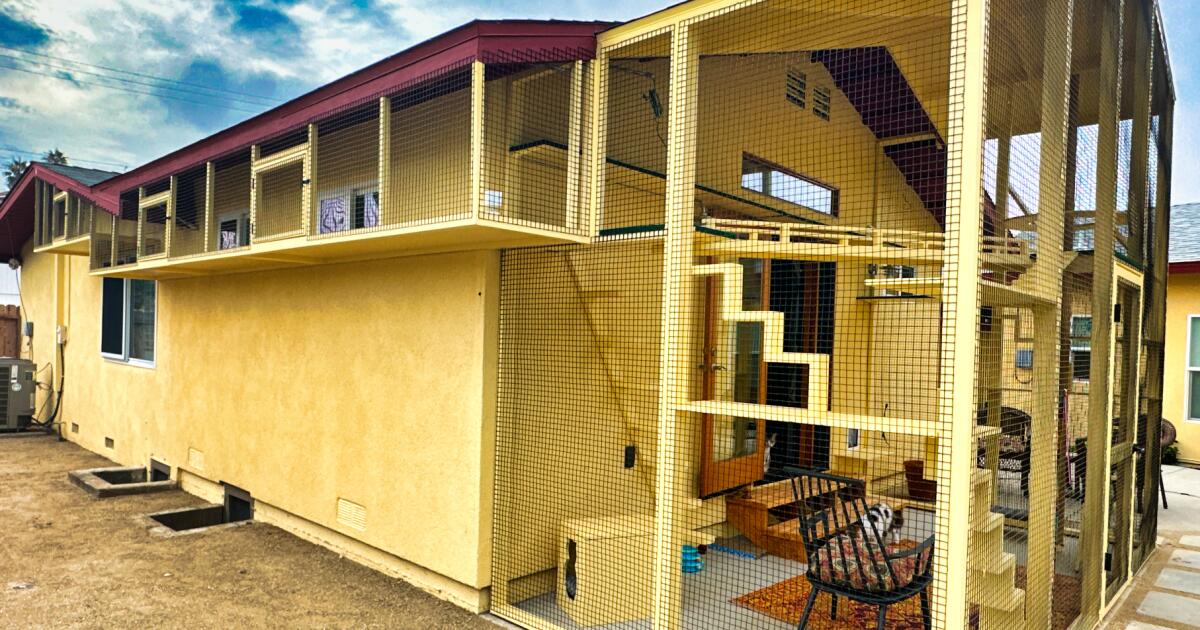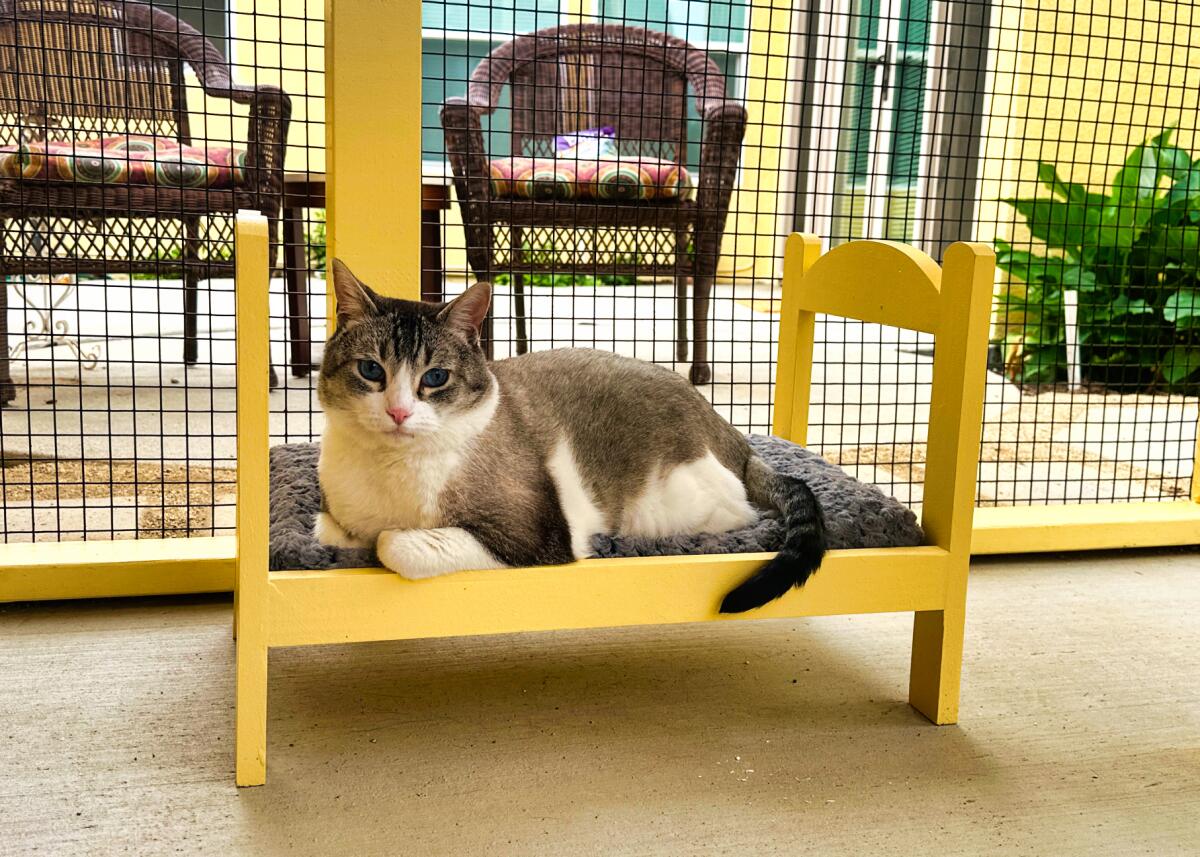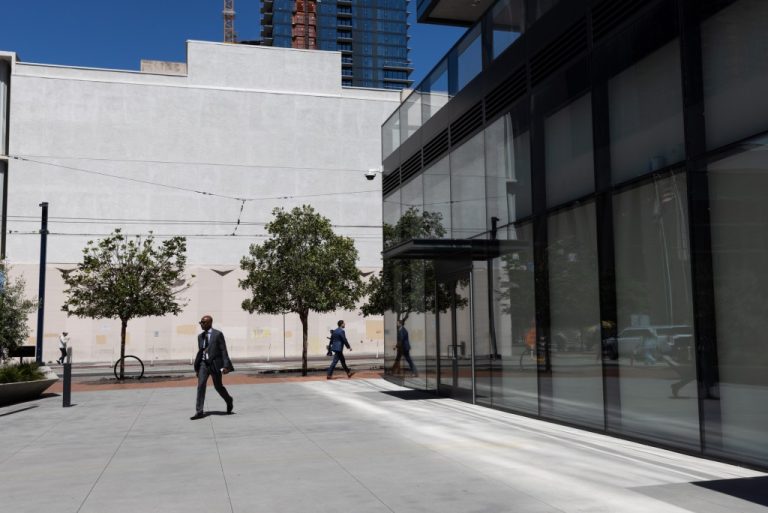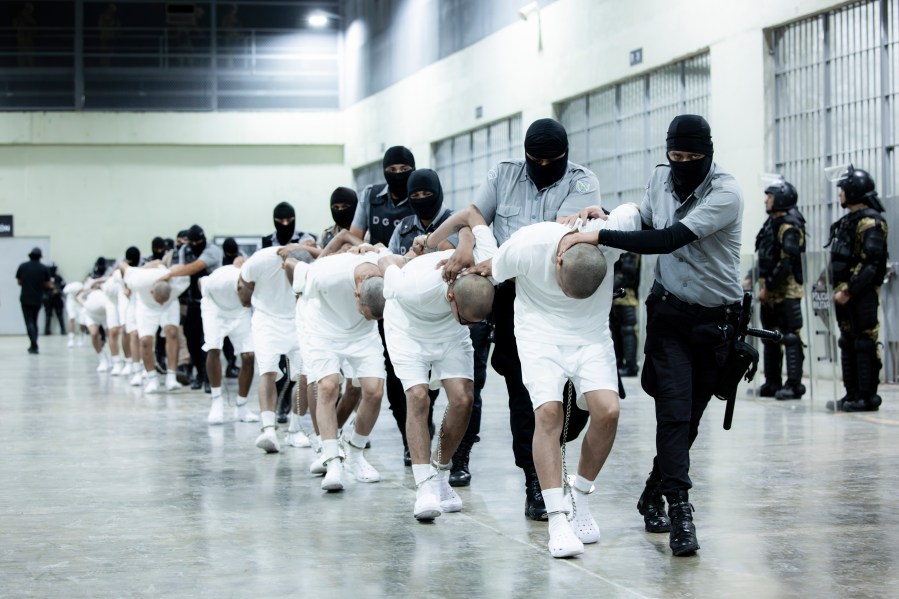
You’ve probably seen the many “lost cat” signs posted in your neighborhood or online on Nextdoor, along with reports of roaming urban coyotes and cats found partially eaten or killed by cars.
While some of those missing are escaped indoor-only cats, the majority are free-roaming or indoor-outdoor cats reputed to kill millions of birds annually. They also live far shorter lives than indoor cats — five years compared with about 17 for indoor cats — the result of dog and predator attacks, exposure to viruses and bacteria picked up from other cats and wildlife, as well as flea and tick infestations.
Yet indoor-only cats as they age can become bored, lethargic and obese from lack of mental stimulation, enrichment and exercise and develop stress-related behavioral problems including fighting with other pets, overgrooming, inappropriate elimination, clawing furnishings and depression.
A catio may be the solution.

Elevated walkways and multiple kitty stairs offer plenty of ways to find the best views.
(Alan Breslauer / @CatioGuy)

A “Disneyland” of catios deserves a princess bed.
(Alan Breslauer / @CatioGuy)
Increasingly, cat parents, many devastated by losing prior cats to coyotes or cars, are turning to outdoor enclosures to keep their beloved pets safe while providing them with the benefits of experiencing nature, fresh air, exercise opportunities and bird-watching stimulation.
Catios range from a simple window box offering fresh air and a safe bird and nature-view perch to a full-blown “Disneyland” playground experience complete with wire-enclosed cat runs, climbing poles, spiral staircases, zigzag steps and all manner of feline-oriented furnishings and perches, plus everything in between, depending on the budgets and space that doting cat parents can devote to their feline family members.
Several Southern Californians relayed why they built catios, with two explaining why and how they became professional catio builders, targeting different markets.

Two of the resident felines at kitten rescuer Hannah Shaw’s home maneuver through the catio on elevated walkways.
(Hannah Shaw / The Kitten Lady)

Chouchou, one of Hannah Shaw’s four cats, surveys her protected outdoor space that was built by Custom Catios.
(Hannah Shaw / The Kitten Lady)
Hannah Shaw, aka The Kitten Lady, known internationally for her work as a neonatal kitten rescuer, educator, author and trainer, moved to San Diego County from Washington, D.C., about five years ago to bring her care for at-risk newborn kittens to our region’s near-year-round kitten season. In late 2020, she and her now-husband found a house they loved in rural East County, home to abundant wildlife, including coyotes.
“One of the first things we did was create a catio off my office. I always wanted one,” Shaw explained.
She recruited Alan Breslauer, aka the Catio Guy, of Custom Catios, a longtime supporter of her nonprofit, the Orphan Kitten Club to design and build a narrow catio over a sidewalk for her four cats. She wanted to use the vertical space to install a 9-foot climbing pole (see “resources” for a link to her construction video), carpeted ramps and an elevated “cat super highway.” She was so pleased with the impact on her cats that she recently added a second larger porch-style catio, with furniture for humans and 20 cat perches, built on her home’s back.

Ferguson (foreground) and Coco, two of Hannah Shaw’s cats, have ample room to play and relax in their catio built by Custom Catios.
(Hannah Shaw / The Kitten Lady)

Coco finds a comfortable perch for lounging in the catio at Hannah Shaw’s home.
(Hannah Shaw / The Kitten Lady)
A North County woman, who requested anonymity, found her way to Custom Catios through Breslauer’s work for Shaw. She explained she saved her pennies to add a special catio for her five indoor cats to her older, 1,000-square-foot home.
“They needed that outdoor stimulation. Alan asked if I wanted to do ‘Disneyland.’ We designed runways, elevated ramps and shelves, all kinds of places they can run. It’s about 8 feet by 16 feet, across the back of the house, with the runway going down the side of the house,” she said.
(“Catio Resources” below includes links to videos of her cats romping happily in their catio.)
Talmadge resident Lorie McDaniel, who lives along a canyon that is home to coyotes, “loves, loves, loves” her cats, a common sentiment among catio builders. That’s why she and her husband (who are in the midst of a remodeling project) opted to convert a third of their enclosed porch overlooking the canyon into a predator-safe catio for their three felines. While renovating their home, they asked their general contractor, Benjamin R. Teeter of Point Loma, to design and build their catio.

David Stesi of Catios by Clear Choice built an elevated 14-foot cat tunnel outside his wife’s office window connecting to a treehouse screened in for safety.
(Brianna Young / Catios by Clear Choice)
“I wanted them to have a place to play, something they’ll use. They can look out and see birds, but not kill them,” she explained. “I wanted a spiral staircase and cat run with different levels reaching the top of the wall where they could do their ‘zoomies’ and get exercise.”
Two Southern Californians who built catios for their own cats’ safety and enrichment turned their newfound passion for the benefits of catios into growing businesses.
David Sesti, a Carlsbad-based licensed general contractor who shares four pampered cats with his wife, Fran, didn’t plan to start a catio-building business.

An enclosure by Catios by Clear Choice has a compact profile but extends up to the second floor.
(Brianna Young / Catios by Clear Choice)
After remodeling their home and adding a separate guest suite in 2017, the Sestis decided to turn the open space into a catio with cat-friendly plants, creating an invisible wire mesh-covered jungle playground, keeping the animals safely inside.
Outside Fran’s office window, David built a large screened window box with an attached elevated 14-foot cat run/tunnel connecting with a cat treehouse, with both treehouse and window box equipped with sherpa-fabric beds for bird-watching.

Stesi started Catios by Clear Choice and builds several structures a month, averaging $1,500 to $7,000 depending on the size, complexity and features included.
(Brianna Young / Catios by Clear Choice)
Next, Sesti constructed a catio for his son and daughter-in-law. Once their daughter-in-law posted photos on Instagram, his unplanned catio business took off. Now Catios by Clear Choice, a subsidiary of his main business, Clear Choice Contracting Inc., builds several catios a month.
“We try to keep them affordable for people. All our catios are custom designed. I ask first for pictures and then do a site visit, measure and help with the design,” Sesti explained.
Their catios average about $1,500 to $7,000, depending upon the size and complexity of the project and often include stairs, ladders, tunnels and runs. He looks for fallen branches along the road to incorporate in his catios for enrichment, with added hanging toys, along with a sherpa bed and scratching post for each cat. Construction and installation typically take one to two days on-site.
“When people realize I’m a general contractor, 99.9 percent of the time we can build what they want, even catios cantilevered over a canyon to a deck or climbing up the side of a house. A catio adds a lot of longevity and stimulation to cats’ lives, the ability to go outside safely,” he said. “We can build something within everyone’s budget. The owners are happy, the cats are happy.”
Breslauer started Los Angeles-based Custom Catios after he had his first catio built for his two cats, who didn’t get along. He had difficulty finding a contractor to construct one on his balcony. After adding the catio, his cats’ relationship changed — and he became a staunch advocate for catios. He’s since observed many bored, unhappy cats’ behavior improve with an outdoor catio and obese cats slim down with increased exercise.

A large tree branch encircled by rope makes an ideal ladder in this enclosure by Catios by Clear Choice.
(Brianna Young / Catios by Clear Choice)
He began designing custom catios part time after seeing the impact on his cats. Soon his business took off, finding a niche, building high-end, often “full Disneyland” catios in the greater L.A. area, with occasional larger projects in San Diego.
“We’re trying to bring joy to cats and their cat guardians. It’s really rewarding,” he said.
Breslauer has built about 400 catios, with 75 percent of them in the $5,000 to $15,000 range and the remainder up to $70,000 and beyond. His elaborate catios — and “catified” interiors — feature extras, including sisal-wrapped climbing poles, fireman’s circles, spiral staircases, bubble beds, cutout hideaway boxes, birdcage beds, carpeted ramps and runways and cat-shaped shelf beds.
Breslauer stressed that catios needn’t be as elaborate, nor should money be an obstacle to getting cats outside safely.
“A catio is doable for any budget, even if it’s prefab or DIY,” he said. “Don’t hold out for perfection. A box with a cat condo inside will make a difference. Every cat going into a catio has their life changed for the better.”
Tips on building a catio
Professional catio builders David Sesti and Alan Breslauer and other catio owners shared tips on designing and constructing a catio for your felines, whether you’re using a kit and doing it yourself, hiring a handyman or a general contractor. The goals are to provide fresh air, stimulation, exercise, entertainment and enrichment to keep cats busy, happy and engaged with nature, while keeping them safe inside away from predators and protecting birds and small animals.
• Don’t skimp on the quality of the materials. You may have to hire someone to correct mistakes or shortcuts. Hire someone who knows and understands cat safety.
• Use redwood for framing and supports because of its durability. Never use pressure-treated lumber because of its toxic chemicals. Cats claw on wood and ingest scratchings when cleaning their paws.
• If your condo requires a painted frame, use Douglas fir and a water-based paint.
• If possible, attach the frame to your building or, if freestanding, firmly to the ground.
• Use concrete if possible for the base. Extend the wire mesh into the ground and, especially if not concrete, even curve it around the base so animals can’t dig under it to invade the catio.
• Use 4-by-4-inch redwood posts for framing and vertical supports with 2-by-2-inch redwood for horizontals and plywood for the shelves.
• For screening, use 2-by-3-inch or 2-by-2-inch 16-gauge wire mesh, galvanized and PVC-coated, although some clients prefer 1-by-1-inch wire mesh.
• Install a human-size exterior door for access for cleaning the litter box and, in case of emergencies, grabbing the cat.
• Use a self-closing door with a lock and latch cats can’t open from inside.
• Provide easy access via a special cat-size window and/or cat flap.
• Depending on the catio size, add furnishings including comfortable cat beds, elevated perches or shelves for sunning and bird watching, a cat ramp, stairs or ladder, a runway for exercise and zoomies, toys, a climbing pole and a cat box hideaway with a cutout for feline privacy.
• For traction on ramps, runways and higher shelves, use industrial outdoor carpeting and, for durability outside, use synthetic rather than natural rope for wrapping climbing poles.
• Use vertical space for an elevated runway accessed via stairs or ramps.
• Provide both shade and sun for your cats, since cats enjoy basking in “sun puddles,” but like to escape the heat.
• Add cat-safe potted plants and cat grass and hang hummingbird and other bird feeders nearby.
For more tips on building catios, visit Catio Spaces.
— Nicole Sours Larson

Alan Breslauer of Custom Catios has built about 400 catios in Southern California, sometimes crafting interiors like these cutout hideaway boxes.
(Alan Breslauer / @CatioGuy)

Special elements in this catio by Alan Breslauer of Custom Catios include — what else — a glass catwalk.
(Alan Breslauer / @CatioGuy)
Catio resources
SPECIALIZED CATIO BUILDERS
Custom Catios: Los Angeles area (builds high-end catios; serves San Diego for larger projects only); Alan Breslauer, (323) 905-4695. customcatios.com, @catioguy, info@customcatios.com
Videos of the North County catio:
bit.ly/CatioGuy-Vista1
bit.ly/CatioGuy-Vista2
Catios By Clear Choice: San Diego/Carlsbad area; David Sesti, (760) 535-2202. catiosbyclearchoice.com, catiosbyclearchoice@gmail.com
Infinity Custom Catios: San Diego area, (817) 915-6298. https://infinitycustomcatios.com, info@infinitycustomcatios.com
PREFABRICATED CATIO KITS
Habitat Haven: habitathaven.com
CDE Animal Cages: cdecages.com/collections/cat-cages
Catbitats: catbitats.com
Purrfect Catio: purrfectcatio.com
DIY CATIO PLANS
Catio Spaces: catiospaces.com (offers many useful articles on designing and building catios)
CAT FENCING COMPANIES
Purrfect Fence: purrfectfence.com
Cat Fence In: catfencein.com
Easy Pet Fence: bit.ly/EasyPetFence-Cats
Oscillot: oscillotamerica.com
CAT FURNITURE
Catastrophic Creations: catastrophicreations.com (modern cat furniture for both catios and “catifying” the home)
OTHER USEFUL CATIO INFORMATION AND RESOURCES
Kitten Lady: kittenlady.org/about and her YouTube tutorial, “Building a Catio for my Cats (From Start to Finish!)” bit.ly/KittenLady-CatioHowTo
Cats Safe at Home: catssafeathome.org
Hauspanther: hauspanther.com (resources for both catios and “catifying the home)
Humane Society of the United States: “Catios: The benefits of outdoor enclosures for cats,” bit.ly/HumaneSociety-CatioBenefits
— Nicole Sours Larson
Sours Larson is a San Diego freelance writer.






